Summary
In August 2007, a 54 year-old mechanic sustained fatal injuries when the aerial work platform he was riding on collapsed. Another worker suffered serious injuries and survived. The incident occurred at a college campus where the two workers were installing a sign on the campus Field House. The Field House is approximately 35 feet high and the sign was to be placed on the upper front section of the building.A boom-supported aerial work platform (aerial work platform) was used to elevate the workers. At the time of the incident, the victim and the co-worker were both inside the lift basket. Both workers wore personal fall arrest systems (PFAS) and the victim's lanyard was attached to the lift basket.
The coworker's lanyard was not attached. At approximately 11:40 am, the boom of the work platform suddenly collapsed and the lift basket crashed to the ground. The victim and the co-worker fell approximately 40 feet. Campus security was notified immediately and paramedics arrived within minutes. Both workers were transported to a hospital where the victim died an hour later. The coworker suffered serious injuries and survived. The collapse of the work platform was determined to be caused by the failure of the upright level cylinder: the rod of the cylinder had broken away from the cylinder barrel.
The investigation found that the rod assembly of the failed cylinder had been modified and this modification caused the cylinder to fail. Due to conflicting statements from the parties involved, the investigators could not determine who modified the rod assembly and when and where the modification was performed.
New York State Fatality Assessment and Control Evaluation (NY FACE) investigators concluded that to help prevent similar incidents from occurring in the future, employers/owners of the aerial work platforms should:
- Prohibit unauthorized modifications or alterations of the aerial work platform;
- Ensure that after purchase of a pre-owned aerial work platform, the machine is thoroughly inspected by a dealer or a qualified mechanic before use;
- Ensure that periodic inspections and preventive maintenance are carried out in strict accordance with the manufacturer's specifications; and
- Keep and maintain operation and maintenance manuals of aerial work platforms; and
- Train all maintenance personnel to strictly follow the manufacturer's requirements when performing machine maintenance.
Introduction
In August 2007, a 54 year-old mechanic sustained fatal injuries after the boom-supported aerial work platform (aerial work platform) he was riding on collapsed. Another worker suffered serious injuries and survived. The incident occurred at a college campus where the two workers were installing a sign on a Field House. Both workers were employed by a sign manufacturing and installation company.On August 15, 2007, a New York State Fatality Assessment and Control Evaluation (NY FACE) investigator traveled to the college campus to observe the incident site.
During the course of her investigation, the NY FACE investigator collected information from the campus fire and emergency service personnel who responded to the incident, and the safety compliance officer of the Occupational Safety and Health Administration (OSHA) who investigated the incident. The NY FACE investigator examined and photographed parts of the hydraulic cylinder of the collapsed aerial work platform. The OSHA investigation report and the Medical Examiner's report were reviewed. The victim's employer declined to participate in the NY FACE investigation.
The victim's employer had been in the sign manufacturing and installation business for fifteen years. At the time of the incident, the company employed seven workers responsible for manufacturing, installing and repairing signs and pylons. The company also owned a crane and lift rental business. The company did not have any safety programs at the time of the incident. The victim had worked for the company five years as a sign mechanic. It was the company's first fatality.
Investigation
At the time of the incident, the sign manufacturing company was contracted to install a sign on the Field House at the college campus. The Field House is approximately 35 feet high and the sign was to be placed on the upper front section of the building at a height of 25 feet. A boom-supported aerial lift was used to elevate the workers who were to install a template and mount plastic letters on the template.The employer purchased the aerial work platform that was a pre-owned 1997 model in 2005. The maximum capacity of the aerial work platform was 500 lbs. The maximum platform height was 45 feet and the maximum horizontal reach was 22.5 feet.
The elevating (boom) assembly of the aerial work platform was composed of six hydraulic cylinders: tower lift, tower telescope, upright level, main lift, main telescope and slave level cylinders (Figure 1). The maximum hydraulic system operating pressure was 3100 pounds per square inch (psi).
Figure 1. The schematic of the boom-supported aerial work platform.
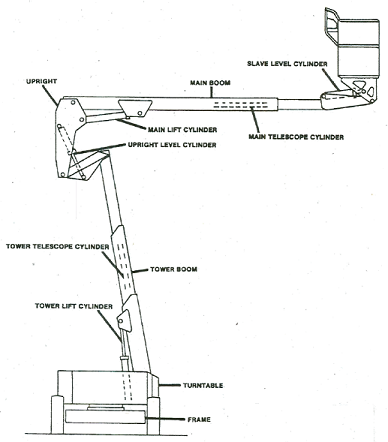
For this specific model of aerial work platform, the manufacturer developed an "Operators and Safety Manual", "Service and Maintenance" manual and an "Illustrated Parts Manual". These manuals were all available through the manufacturer and could be downloaded from the manufacturer's website. The sign company did not maintain a copy of any of these manuals. Instead, the company kept a copy of the "Boom Lift Operation and Safety Handbook" that was developed by the same manufacturer.
The Handbook did not contain specific information on operation, service and maintenance of this specific aerial work platform model, but had general safety guidance for operating any boom-supported aerial work platform produced by this manufacturer. The employer never had the aerial work platform inspected by a dealer or a mechanic who specialized in the specific make and model of the work platform as required by the manufacturer.
It was the first day of the job and the victim and the co-worker arrived at the Field House in the morning. A summer camp was being held inside the Field House that morning. The aerial work platform was parked on the concrete surface in front of the Field House entrance (Photo1). At the time of the incident, the victim and the coworker were both inside the lift basket. Both workers wore personal fall arrest systems (PFAS), and the victim's lanyard was attached to the lift basket. The coworker's lanyard was not attached.
Photo 1. The Field House entrance where the aerial work platform was parked during the incident.
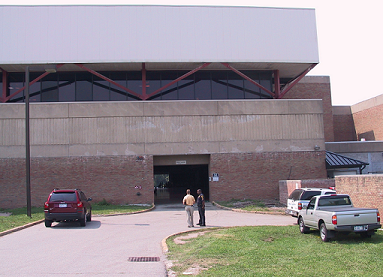
The trailer was equipped with walking floor, an automated unloading mechanism (Photo 3). The walking floor was composed of three groups of narrow movable slats that were powered by hydraulics. The groups of floor slats could move alternately or simultaneously forward and backward. The load was moved during unloading when all floor slats moved simultaneously towards the discharge end.
The company reported that drivers usually cover the front trailer wall and a section of the floor before loading. It was believed that the tarp that moved along with the load could keep debris off the floor and reduce manual sweeping after unloading. After the incident, a piece of blue tarp was found buried in the mulch in the trailer.
It is believed that the victim may have entered the trailer from the rear to cover the walking floor with the tarp just prior to when the loader operator approached the trailer with the first load of mulch.
At approximately 11:40 am, the lift basket fell to the ground and landed on the grassy surface (Photo 2). A camp student heard the crashing noise; he came outside and saw the collapsed aerial work platform.
The victim was inside the basket and the co-worker was on the grass in front of the basket. Campus security was notified immediately and paramedics arrived within minutes.
Both workers were transported to a hospital where the victim died an hour later. The co-worker had serious injuries and survived. Based on measurements taken at the incident site, it was estimated that the victim and the co-worker fell approximately 40 feet.
Photo 2. The aerial work platform collapsed during the incident and the lift basket crashed to the ground and landed on the grassy surface by the Field House (Photo courtesy of OSHA).
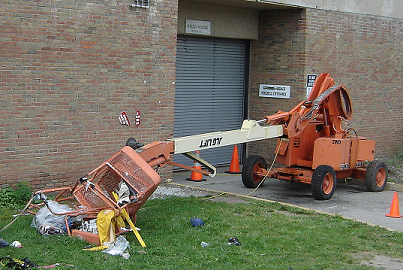
The collapse of the aerial work platform was determined to be caused by a failure of the upright level cylinder (Figure 1): the rod of the cylinder had broken away from the cylinder barrel (Photo 3). After the incident, a mechanic who specialized in the model and make of the aerial work platform examined the failed cylinder. The mechanic concluded that the rod assembly of the cylinder had been modified and the modification directly caused the failure of the cylinder.
Photo 3. Top view of the collapsed aerial work platform with the rod completely separated from the upright level cylinder (Photo courtesy of OSHA)
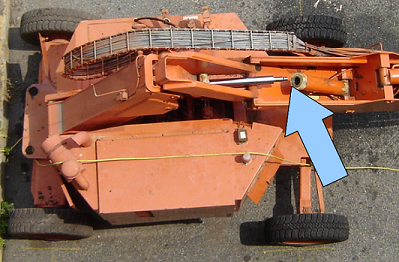
The original rod assembly of the cylinder had a threaded end. The piston was secured to the rod by a hex nut that screwed into the threaded end. The hex nut had a set screw to secure it to the rod. The investigation found that the thread of the rod assembly of the failed cylinder was ground off. A hole was drilled through the hex nut and the rod (Photo 4 and Photo 5). A bolt had been inserted through the hex nut and the rod and it was fastened with a nut. The bolt broke into three pieces (Photo 6) during the incident and caused the cylinder to fail.
Photo 4. The thread of the failed cylinder rod was ground off and a hole had been drilled through the rod.
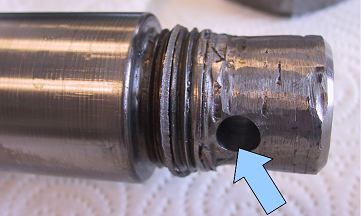
Photo 5. The hex nut was drilled through so that a bolt can be inserted to hold the rod and the nut together.
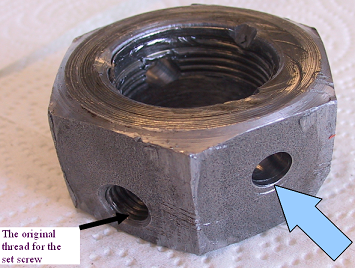
Photo 6. A bolt had been inserted through the hex nut and the rod and it was fastened with a nut. The bolt broke into three pieces during the incident and caused the cylinder to fail.
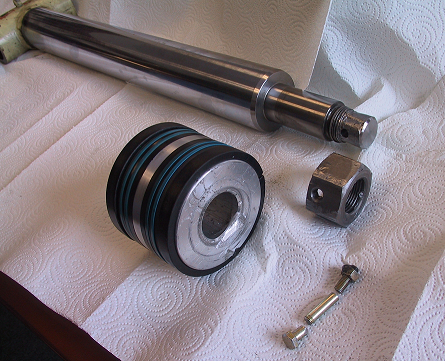
In early April, four months before the incident, the upright level cylinder reportedly had a leak. The victim and another employee brought the cylinder to a machine shop owner to have it repaired. The owner of the machine shop stated that the cylinder arrived in two pieces: the rod assembly was already removed from the cylinder. He observed that the hex nut was fastened to the rod by a bolt and nut. He also noted that the rod end where the hex nut was attached was fully threaded (not grounded off or damaged).
The machine shop owner replaced the packing seals on the piston and completed the repair job. The victim picked up the cylinder three days later. The machine shop owner recalled that an employee from the sign manufacturing company called the next day and reported that the cylinder had air in it. The machine shop owner instructed him on bleeding the air out of the cylinder. That was the last time the machine shop owner heard about the cylinder.
Due to conflicting statements from the parties involved, the investigators could not determine who modified the rod assembly and when and where the modification was performed.
Recommendations/Discussion:
Recommendation #1: Owners of aerial work platforms should prohibit unauthorized modifications or alterations of the machines.Discussion: Modification or alteration of aerial work platform parts or components may compromise the integrity of the machine and cause serious or fatal injuries. The serious and potentially life threatening consequences of unauthorized modification of aerial work platform parts or structure should be clearly communicated to all employees, including both operators and maintenance staff.
Recommendation #2: Before using a pre-owned aerial work platform, the owner should have the machine thoroughly inspected by a dealer or a qualified mechanic.
Discussion: The aerial work platform manufacturer recommends a thorough inspection before a new machine is put into operation. The initial inspection for a new machine is intended to identify damages that may have resulted from shipping. A pre-owned machine warrants a more extensive initial inspection since it may have worn or damaged parts or structure due to previous usage in addition to possible shipping damage. As soon as a pre-owned aerial work platform is purchased, the owner should arrange for a complete inspection before putting the machine into service.
The inspection should be performed by a dealer or a qualified mechanic who is specialized in the make and model of the aerial work platform to ensure that no modification had been made to the machine and that the machine is safe to operate. If an unauthorized modification is detected, modified parts or components should be replaced immediately with the original parts or components. The owner should consult the aerial work platform manufacturer for a complete evaluation of the integrity of the machine. The machine should not be allowed in service unless the manufacturer or a qualified mechanic certifies that the machine is safe to use.
Recommendation #3: The owners of aerial work platforms should ensure that periodic inspections and preventive maintenance are carried out strictly in accordance with the manufacturer's specifications.
Discussion: A systematic and thorough inspection can detect defective, damaged or improperly installed parts and ensure the safe operation of an aerial work platform. Owners should establish and implement a preventive maintenance program and strictly follow the machine inspection schedule in accordance with the manufacturer's recommendations. All malfunctions and problems identified during the inspections should be corrected before returning an aerial work platform back to service.
The manufacturer in this case required that the aerial work platform receive inspections performed by a dealer or a qualified mechanic:
- Before a new machine is first put into service;
- Every month or more often warranted by environmental conditions, and severity and frequency of use; and
- Every year.
From 2005 when it was purchased until the day of the incident in August 2007, the aerial work platform had not been inspected by a dealer or a qualified mechanic. The machine shop owner who repaired the cylinder apparently was not familiar with the machine, since he was not able to detect the modified cylinder rod. If the aerial work platform had been inspected by a qualified person at the frequency required by the manufacturer, the modified part may have been identified and replaced and the incident may have been prevented.
Recommendation #4: he owners should keep and maintain manufacturer's operating and maintenance manuals for the specific model of the aerial work platforms.
Discussion: Owners should keep and maintain copies of the operating and maintenance manuals for the specific models that they own. These manuals are considered to be an integral part of the aerial work platforms and are vital for communicating the necessary safety information to operators and maintenance personnel. All information in these manuals should be read and understood before any attempt is made to operate an aerial work platform.
Recommendation #5: Employers should provide training and ensure that all maintenance personnel strictly follow the manufacturer's requirements when performing machine maintenance.
Discussion: Employers should train their maintenance personnel to strictly follow the manufacturer's requirements when performing troubleshooting or preventive maintenance. No one should be allowed to work on the aerial work platforms unless competency is demonstrated. The maintenance personnel should use only the parts or components that are approved by the manufacturer for replacement. Modification or alteration of the parts or structure of an aerial work platform should be strictly prohibited.
REFERENCES
- OSHA. Vehicle-mounted elevating and rotating work platforms, 29CFR1910.67. Retrieved May 18, 2009
- American National Standard. ANSI/SIA A92.5-1992. "Boom-supported Elevating Work Platforms". Scaffold Industry Association, Inc.